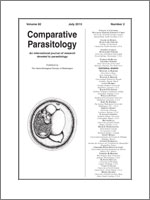Many modern-day studies require parasite samples essentially free of environmental contamination. Techniques used to prepare gastrointestinal nematode eggs from livestock are sufficient for biological studies but fall woefully short of generating pure preparations for downstream molecular, biochemical, and immunological studies. Consequently, a method to produce highly purified nematode parasite eggs free from fecal contamination is needed. The present study compared different procedures for egg isolation and attempted to improve the purity of Ostertagia ostertagi eggs isolated from cattle feces. The Wisconsin method using saturated sucrose has been used widely to enrich eggs from feces and is adequate for identification and counting. A more-recently developed method using the combination of salt and sucrose is robust and consistent and can be used to isolate eggs with much higher purity; however, residual fecal materials are still present in the egg preparations, which could account for large levels of nonspecific DNA and RNA contamination in the final samples. While large numbers of eggs can be harvested from the medium of overnight, in vitro-cultured adult worms, this method is labor intensive, involves euthanasia of animals, and requires the purification of adult worms to high purity and subsequent culturing to acquire the eggs. In addition, a large proportion of the eggs initiate development and hatch during isolation. In the current method, Ostertagia eggs free from fecal contamination were secondarily purified using lymphocyte separation medium (LSM) from eggs previously enriched by the Wisconsin method. The egg recovery following the LSM step was 100%. The results indicate that this two-step method involving sucrose and LSM was simple, rapid, nonselective, and greatly improved the purity of Ostertagia eggs. This method will have broad application for isolating eggs of the superfamily of Trichostrongyloidea, which includes the most-important nematode parasites infecting livestock.
How to translate text using browser tools
1 July 2015
A Two-Step Method to Generate Highly-Purified Nematode Eggs from Feces: Sucrose Flotation Followed by Density Gradient Centrifugation Using Lymphocyte Separation Medium
Wenbin Tuo,
Dante Zarlenga,
Deborah Hebert,
Eliseo Miramontes,
Raymond Fetterer
ACCESS THE FULL ARTICLE

Comparative Parasitology
Vol. 82 • No. 2
July 2015
Vol. 82 • No. 2
July 2015
egg
gastrointestinal nematode
isolation
Ostertagia ostertagi
parasite




